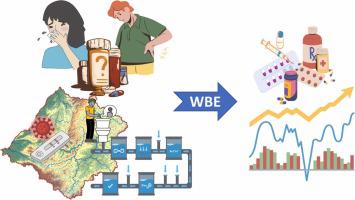当前位置:
X-MOL 学术
›
J. Hazard. Mater.
›
论文详情
Our official English website, www.x-mol.net, welcomes your feedback! (Note: you will need to create a separate account there.)
Understanding treatment of pain during SARS-CoV-2 pandemic in a two-year intercity longitudinal study using wastewater-based epidemiology
Journal of Hazardous Materials ( IF 13.6 ) Pub Date : 2024-04-12 , DOI: 10.1016/j.jhazmat.2024.134121 Nicola Ceolotto , Kishore Jagadeesan , Like Xu , Richard Standerwick , Megan Robertson , Ruth Barden , Julie Barnett , Barbara Kasprzyk-Hordern
Journal of Hazardous Materials ( IF 13.6 ) Pub Date : 2024-04-12 , DOI: 10.1016/j.jhazmat.2024.134121 Nicola Ceolotto , Kishore Jagadeesan , Like Xu , Richard Standerwick , Megan Robertson , Ruth Barden , Julie Barnett , Barbara Kasprzyk-Hordern

|
SARS-CoV-2 pandemic had a significant impact on the society, economy, and health of people around the world with consequences that need to be better understood for future pandemic preparedness. This manuscript provides insights into the usage of pharmaceuticals for pain treatment management throughout SARS-CoV-2 pandemic. Four towns and cities with a total population of > 1 million people covering an area of 2000 km in South West England were monitored for twenty-four months. Results showed different patterns in pain pharma usage, with small towns having higher population normalised daily loads (PNDLs) than big cities for majority of pain killers studied. This is likely due to demographics of these cities with smaller cities having older population. Per capita consumption of non-steroidal anti-inflammatory drugs (NSAIDs) increased compared to pre-pandemic usage in line with SARS-CoV-2 infections (ibuprofen and acetaminophen), while body pain drugs (diclofenac and naproxen) decreased in line with restrictions and closure of sports facilities. Changes in population normalised daily intake (PNDI) of pain killers were particularly apparent during the 1st and 3rd national lockdown. Comparison of PNDIs with prescriptions highlighted differences related to medication availability (OTC drugs) and patients’ nonadherence (prescribed drugs). In addition, several instances of direct disposal events across the catchments were observed which raises an issue of lack of pharma compliance and general understanding of potential environmental impacts from pharma usage.
中文翻译:

使用基于废水的流行病学进行为期两年的城际纵向研究,了解 SARS-CoV-2 大流行期间的疼痛治疗
SARS-CoV-2 大流行对世界各地人民的社会、经济和健康产生了重大影响,需要更好地了解其后果,以便为未来的大流行做好准备。本手稿提供了有关在 SARS-CoV-2 大流行期间使用药物进行疼痛治疗管理的见解。对英格兰西南部面积 2000 平方公里、总人口超过 100 万的四个城镇进行了为期 24 个月的监测。结果显示止痛药物的使用模式不同,对于所研究的大多数止痛药来说,小城镇的人口标准化日负荷 (PNDL) 高于大城市。这可能是由于这些城市的人口统计数据显示,小城市的人口老龄化。与大流行前相比,非甾体抗炎药 (NSAID) 的人均消费量因 SARS-CoV-2 感染而有所增加(布洛芬和对乙酰氨基酚),而身体止痛药(双氯芬酸和萘普生)则因限制而减少并关闭体育设施。在第一次和第三次全国封锁期间,人口标准化每日止痛药摄入量 (PNDI) 的变化尤其明显。 PNDI 与处方药的比较突出了与药物可用性(非处方药)和患者不依从性(处方药)相关的差异。此外,还观察到跨流域发生的几起直接处置事件,这引发了缺乏药品合规性和对药品使用潜在环境影响的普遍了解的问题。
更新日期:2024-04-12
中文翻译:

使用基于废水的流行病学进行为期两年的城际纵向研究,了解 SARS-CoV-2 大流行期间的疼痛治疗
SARS-CoV-2 大流行对世界各地人民的社会、经济和健康产生了重大影响,需要更好地了解其后果,以便为未来的大流行做好准备。本手稿提供了有关在 SARS-CoV-2 大流行期间使用药物进行疼痛治疗管理的见解。对英格兰西南部面积 2000 平方公里、总人口超过 100 万的四个城镇进行了为期 24 个月的监测。结果显示止痛药物的使用模式不同,对于所研究的大多数止痛药来说,小城镇的人口标准化日负荷 (PNDL) 高于大城市。这可能是由于这些城市的人口统计数据显示,小城市的人口老龄化。与大流行前相比,非甾体抗炎药 (NSAID) 的人均消费量因 SARS-CoV-2 感染而有所增加(布洛芬和对乙酰氨基酚),而身体止痛药(双氯芬酸和萘普生)则因限制而减少并关闭体育设施。在第一次和第三次全国封锁期间,人口标准化每日止痛药摄入量 (PNDI) 的变化尤其明显。 PNDI 与处方药的比较突出了与药物可用性(非处方药)和患者不依从性(处方药)相关的差异。此外,还观察到跨流域发生的几起直接处置事件,这引发了缺乏药品合规性和对药品使用潜在环境影响的普遍了解的问题。



























 京公网安备 11010802027423号
京公网安备 11010802027423号